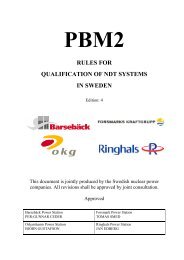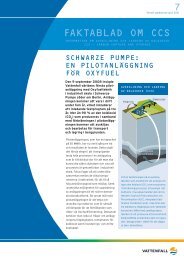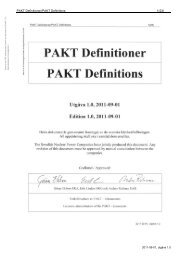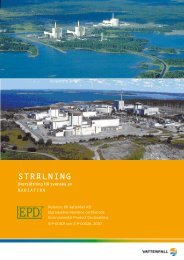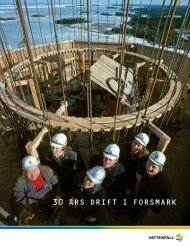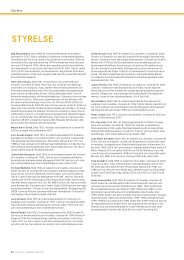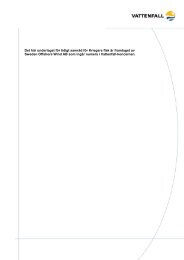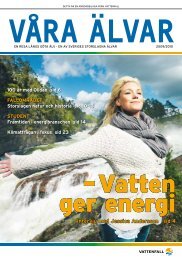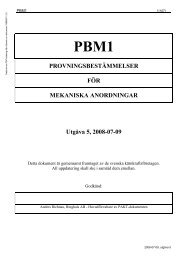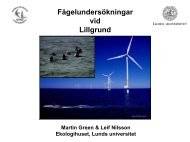Birds in southern Öresund in relation to the wind farm at ... - Vattenfall
Birds in southern Öresund in relation to the wind farm at ... - Vattenfall
Birds in southern Öresund in relation to the wind farm at ... - Vattenfall
Create successful ePaper yourself
Turn your PDF publications into a flip-book with our unique Google optimized e-Paper software.
species, some species be<strong>in</strong>g better covered from bo<strong>at</strong>, while aerial surveys makes it possible<br />
<strong>to</strong> cover larger areas with<strong>in</strong> short time (see Komdeur et al. 1992, Nilsson 1975). Moreover,<br />
aerial surveys were <strong>the</strong> only way <strong>to</strong> cover both <strong>the</strong> Lillgrund area and a reference area <strong>in</strong> one<br />
day<br />
Both dur<strong>in</strong>g <strong>the</strong> base-l<strong>in</strong>e studies and <strong>the</strong> post construction surveys a very marked vari<strong>at</strong>ion <strong>in</strong><br />
<strong>the</strong> number of stag<strong>in</strong>g and w<strong>in</strong>ter<strong>in</strong>g w<strong>at</strong>er birds were found both dur<strong>in</strong>g <strong>the</strong> bo<strong>at</strong> counts and<br />
aerial surveys. The same vari<strong>at</strong>ion was found dur<strong>in</strong>g <strong>the</strong> aerial surveys both for <strong>the</strong> Lillgrund<br />
area and for <strong>the</strong> reference area south of Falsterbo, apply<strong>in</strong>g <strong>to</strong> all species of <strong>in</strong>terest here. This<br />
k<strong>in</strong>d of vari<strong>at</strong>ion is typical for stag<strong>in</strong>g and w<strong>in</strong>ter<strong>in</strong>g w<strong>at</strong>er birds and especially for offshore<br />
sea ducks, which shows a very dynamic occurrence even if some areas hold regular<br />
concentr<strong>at</strong>ions (Nilsson 1972, 1975, 2008, <strong>in</strong> prep.).<br />
Due <strong>to</strong> <strong>the</strong> very marked vari<strong>at</strong>ion <strong>in</strong> <strong>the</strong> counts and <strong>the</strong> rel<strong>at</strong>ively low numbers of surveys it<br />
was not mean<strong>in</strong>gful <strong>to</strong> make any formal st<strong>at</strong>istical analysis of <strong>the</strong> pre- and post-construction<br />
situ<strong>at</strong>ion of <strong>the</strong> utiliz<strong>at</strong>ion for different zones around <strong>the</strong> w<strong>in</strong>d<strong>farm</strong>. For this a much more<br />
<strong>in</strong>tensive study with a larger number of surveys would be necessary, but this was not possible<br />
with<strong>in</strong> <strong>the</strong> moni<strong>to</strong>r<strong>in</strong>g program. For practical reasons it would also have been difficult <strong>to</strong><br />
obta<strong>in</strong> enough surveys due <strong>to</strong> logistical problems, e.g. suitable aircrafts were only available<br />
for one full season before <strong>the</strong> establishment of <strong>the</strong> w<strong>in</strong>d<strong>farm</strong> and bo<strong>at</strong> surveys <strong>in</strong> <strong>the</strong> last two<br />
(most <strong>in</strong>terest<strong>in</strong>g) post-construction years could not be performed dur<strong>in</strong>g <strong>the</strong> important w<strong>in</strong>ter<br />
period due <strong>to</strong> <strong>the</strong> ice conditions.<br />
Before <strong>the</strong> w<strong>in</strong>d<strong>farm</strong> was built small groups of Long-tailed Ducks were regular on Lillgrund.<br />
Dur<strong>in</strong>g <strong>the</strong> first post-construction year <strong>the</strong> Long-tailed Ducks clearly avoided <strong>the</strong> w<strong>in</strong>d <strong>farm</strong><br />
area but l<strong>at</strong>er years show a less clear p<strong>at</strong>tern. Some birds were seen with<strong>in</strong> <strong>the</strong> w<strong>in</strong>d <strong>farm</strong><br />
show<strong>in</strong>g th<strong>at</strong> avoidance is <strong>at</strong> least not 100 %. It may also be th<strong>at</strong> some sort of habitu<strong>at</strong>ion is<br />
<strong>in</strong>volved, but <strong>the</strong> low numbers encountered makes it hard <strong>to</strong> do any robust <strong>in</strong>terpret<strong>at</strong>ion of<br />
<strong>the</strong> results. It should also be remembered th<strong>at</strong> <strong>the</strong> Long-tailed Duck is a rel<strong>at</strong>ively sparse bird<br />
<strong>in</strong> <strong>sou<strong>the</strong>rn</strong> <strong>Öresund</strong>, this region be<strong>in</strong>g a marg<strong>in</strong>al w<strong>in</strong>ter area for <strong>the</strong> species.<br />
For <strong>the</strong> Eider, <strong>the</strong> Lillgrund area clearly had a large <strong>at</strong>traction, especially for feed<strong>in</strong>g birds <strong>in</strong><br />
spr<strong>in</strong>g, fly<strong>in</strong>g <strong>to</strong> <strong>the</strong> area from <strong>the</strong> colony on Saltholm a short distance <strong>to</strong> <strong>the</strong> north. This<br />
<strong>at</strong>traction <strong>to</strong> <strong>the</strong> Lillgrund area was still <strong>the</strong>re <strong>in</strong> <strong>the</strong> first post-construction years, but now <strong>the</strong><br />
Eiders were concentr<strong>at</strong>ed <strong>to</strong> <strong>the</strong> parts of Lillgrund just outside <strong>the</strong> w<strong>in</strong>d <strong>farm</strong>, seem<strong>in</strong>gly<br />
avoid<strong>in</strong>g <strong>the</strong> w<strong>in</strong>d <strong>farm</strong>. In <strong>the</strong> last survey year, some larger flocks were seen <strong>in</strong> <strong>the</strong> w<strong>in</strong>d <strong>farm</strong><br />
and this may be a sign of habitu<strong>at</strong>ion.<br />
Also for <strong>the</strong> third sea duck species found <strong>in</strong> <strong>the</strong> area, <strong>the</strong> Red-breasted Merganser, <strong>the</strong>re were<br />
some signs of <strong>in</strong>itial avoidance of <strong>the</strong> w<strong>in</strong>d <strong>farm</strong> area. Results are however less clear<br />
compared <strong>to</strong> <strong>the</strong> o<strong>the</strong>r two duck species and numbers us<strong>in</strong>g <strong>the</strong> whole <strong>Öresund</strong> area has been<br />
lower dur<strong>in</strong>g <strong>the</strong> post-construction years compared <strong>to</strong> before. Hence, <strong>the</strong> actual effect of <strong>the</strong><br />
w<strong>in</strong>d <strong>farm</strong> is hard <strong>to</strong> evalu<strong>at</strong>e and <strong>the</strong> found changes <strong>in</strong> abundance may very well be rel<strong>at</strong>ed <strong>to</strong><br />
o<strong>the</strong>r fac<strong>to</strong>rs.<br />
For <strong>the</strong> o<strong>the</strong>r two common species <strong>in</strong> <strong>the</strong> area we could not f<strong>in</strong>d any clear effects of <strong>the</strong><br />
establishment of <strong>the</strong> w<strong>in</strong>d <strong>farm</strong>. Cormorants could actually be <strong>at</strong>tracted <strong>to</strong> <strong>the</strong> fundaments and<br />
use <strong>the</strong>m as roost<strong>in</strong>g places, although this could not be shown by our analysis. When it comes<br />
<strong>to</strong> <strong>the</strong> Herr<strong>in</strong>g Gull fewer flocks were seen <strong>in</strong> <strong>the</strong> w<strong>in</strong>d<strong>farm</strong> area post-construction but most of<br />
<strong>the</strong> concentr<strong>at</strong>ions seen <strong>in</strong> this species were rel<strong>at</strong>ed <strong>to</strong> fish<strong>in</strong>g vessels. Fish<strong>in</strong>g is allowed <strong>in</strong><br />
77




